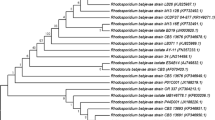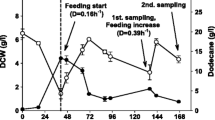Abstract
Biosurfactants are a family of diverse amphipathic molecules that are produced by several microorganisms such as bacteria, molds, and yeasts. These surface active agents have several applications in agriculture, oil processing, food, and pharmaceutical industries. In this research using YMG and YUG culture media, a native yeast strain, HG5, was isolated from honey bee. The oil spread test as a screening method was used to evaluate biosurfactant production by the yeast HG5 isolate. The 5.8s-rDNA analysis confirmed that the isolated yeast was related to Lachancea thermotolerans. We named this strain Lachancea thermotolerans strain BBMCZ7FA20 and its 5.8s-rDNA sequence was deposited in GenBank, NCBI under accession number of KM042082.1. The best precursor of biosurfactant production was canola oil and the sophorolipid amount was measured for 24.2 g/l. The thin layer chromatography and Fourier Transform Infrared Spectroscopy analysis showed that the extracted biosurfactant from Lachancea thermotolerans was sophorolipid. In conclusion, this is the first report of sophorolipid production by a native yeast Lachancea thermotolerans BBMCZ7FA20 we isolated from the honey bee gut collected from an apiary farm in Saman, Chaharmahal Bakhtiari province, Iran. We suggested that some cost-effective supplements such as canola oil, sunflower oil, and corn oils could be applied for increasing the sophorolipid production by this native yeast strain. According to several applications of biosurfactants in today world, the production of sophorolipid by Lachancea thermotolerans could be considered as a potential in the current industrial microbiology and modern microbial biotechnology.





Similar content being viewed by others
References
Al-Araji L, Rahman RNZRA, Basri M, Salleh AB (2007) Microbial surfactant. Asia Pac J Mol Biol Biotechnol 15:99–105
Arthur Felse P, Shah V, Chan J, Kandula J, Gross RA (2007) Sophorolipid biosynthesis by Candida bombicola from industrial fatty acid residues. Enzym Microbiol Technol 40:316–323
Asmer HJ, Lang S, Wagner F, Wray V (1988) Microbial production structure elucidation and bioconversion of sophorose lipids. AOCS J 65:1460–1466
Banat IM (1993) The isolation of a thermophilic biosurfactant producing Bacillus species. Biotechnol Lett 15:591–594
Banat IM (1995) Biosurfactants production and possible uses in microbial enhanced oil recovery and oil pollution remediation: a review. Biores Technol 51:1–12
Carrill PG, Mardaraz C, Pitta-Alvarez SJ, Giulietti AM (1996) Isolation and selection of biosurfactant producing bacteria. World J Microbiol Biotechnol 12:82–84
Cavalero DA, Cooper DG (2003) The effect of medium composition on the structure and physical state of sophorolipids produced by Candida bombicola ATCC 22214. J Biotechnol 103:31–41
Chen J, Song X, Bin M, Ren J, Qu Y (2006) Production structure elucidation and anticancer properties of sophorolipid from Wickerhamiella domercqiae. Enzym Microbiol Technol 39:501–506
Daverey A, Pakshirajan K (2009) Production characterization and properties of sophorolipids from the yeast Candida bombicola using a low-cost fermentative medium. Food Res Int 42:499–504
Davila AM, Marchal R, Monin N, Vandecasteele JP (1993) Identification and determination of individual sophorolipids in fermentation products by gradient elution high-performance liquid-chromatography with evaporative light-scattering detection. J Chromatogr 648:139–149
Desai JD, Banat IM (1997) Microbial production of surfactants and their commercial potential. MMBR 61:47–64
Gautam KK, Tyagi VK (2006) Microbial surfactants: a review. J Oleo Sci 55:155–166
Gilliam M, Omnrto HL, Prest DB, Martin RD, Wickerham LJ (1977) The mycoflora of adult worker honeybees, Apis mellifera : effects of 2,4,5-T and caging of bee colonies. J Invertebr Pathol 30:50–54
Gilliam M (1979) Microbiology of pollen and bee: the yeasts. Apidol 10:43–53
Gorin PAJ, Spencer JFT, Tulloch AP (1961) Hydroxy fatty acid glycosides of sophorose from Torulopsis magnoliae. Can J Chem 39:846–855
Gumienna M, Zawirska-Wojtasiak R, Czarnecka M, Czarnecki Z (2003) Effect of fat substrate on extracellular lioplytic activity of Candida bombicola ATCC 22214. PJFNS 2:15–20
Harju S, Fedosyuk H, Peterson KR (2004) Rapid isolation of yeast genomic DNA: bust n’ Grab. BMC Biotechnol 4:8–12
Li H, Ma X, Shao L, Shen J, Song X (2012) Enhancement of sophorolipid production of Wickerhamiella domercqiae var. sophorolipid CGMCC 1576 by low energy ion beam implantation. Appl Biochem Biotechnol 167:510–523
Morikawa M, Ito M, Imanaka T (1992) Isolation of a new surfactin producer Bacillus pumilusA-1, and cloning and nucleotide sequence of the regulator gene, psf-1. J Ferment Bioeng 74:255–261
Parekh VJ, Patravaleb VB, Pandita Mango AB (2012) kernel fat: a novel lipid source for the fermentative production of sophorolipid biosurfactant using Starmerella bombicola NRRL-Y 17069. Anal Biol Res 3:1798–1803
Pekin G, Sukan FV, Kusaric N (2005) Production of sophorolipid from candida bombicola ATCC 22214 using turkish corn oil and honey. Eng Life Sci 5:357–362
Satpute SK, Banporkar AG, Dhakephalkar PK, Banat IM, Chopade BA (2010) Methods for investigating biosurfactants and bioemulsifiers: a review. Crit Rev Biotechnol 3:1–18
Sudha S, Kumanan R, Vijayashree P, Muthusamy K (2010) Comparative study for the production, characterisation and antimicrobial studies of sophorolipid using Candida tropicalis. Asian J Pharm Clin Res 3:47–53
Tulloch AP, Spencer JFT (1968) Fermentation of long-chain compounds by Torulopsis apicola. Products from esters and hydrocarbons with 14 and 15 carbon atoms and from methyl palmitoleate. Can J Chem 46:1523–1528
Vedaraman N, Venkatesh NM (2010) The effect of medium composition on the production of sophorolipids and the tensiometric properties by Starmerella bombicola MTCC 1910. Pol J Chem Technol 12:9–13
Wadekar SD, Kale SB, Lali AM, Bhowmick DN, Pratap AP (2012) Utilization of sweet water as a cost-effective carbon source for sophorolipids production by Starmerella bombicola (ATCC 22214). Prep Biochem Biotechnol 42:125–142
Wickerham LJ (1951) Taxonomy of yeasts. US Dept Agric Tech Bull 1029:1–55
Wickerham LJ, Burton KA (1954) A clarification of the relationship of Candida guilliermondii to other yeasts by a study of their mating types. J Bacteriol 68:594–597
Youssef NH, Duncana KE, Naglea DP, Savagea KN, Knappb RM, McInerney MJ (2004) Comparison of methods to detect biosurfactant production by diverse microorganisms. J Microbiol Methods 6:339–347
Acknowledgments
We thank the Vice Chancellor Office of Research and Technology, Falavarjan Branch, Islamic Azad University, Isfahan, Iran for technical and academic supports. The authors would like to thank the staffs of laboratory of organic chemistry, Shahreza Branch, Islamic Azad University for their technical supports in TLC and FTIR analysis.
Author information
Authors and Affiliations
Corresponding author
Rights and permissions
About this article
Cite this article
Mousavi, F., Beheshti-Maal, K. & Massah, A. Production of Sophorolipid from an Identified Current Yeast, Lachancea thermotolerans BBMCZ7FA20, Isolated from Honey Bee. Curr Microbiol 71, 303–310 (2015). https://doi.org/10.1007/s00284-015-0841-7
Received:
Accepted:
Published:
Issue Date:
DOI: https://doi.org/10.1007/s00284-015-0841-7




